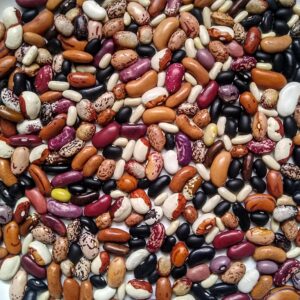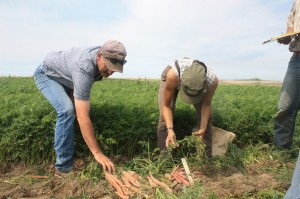
 On August 15, 2013, I participated in a listening session hosted by USDA’s Plant Breeding Working Group. OSA is grateful that USDA hosted this day-long event that invited comments and discussion from different stakeholders — from public and private plant breeders, to farm groups and forest scientists. For those who couldn’t attend, USDA collected written comments through last month. If you’re wondering what’s next, the agency’s blog reports that: “this input will be valuable for USDA’s strategy on where to place ever more scarce plant breeding resources, and it will hopefully generate a forward-looking dialogue in the community that will enable it to be more responsive to future needs of plant breeding in an ever-changing and ever more populated world.”
On August 15, 2013, I participated in a listening session hosted by USDA’s Plant Breeding Working Group. OSA is grateful that USDA hosted this day-long event that invited comments and discussion from different stakeholders — from public and private plant breeders, to farm groups and forest scientists. For those who couldn’t attend, USDA collected written comments through last month. If you’re wondering what’s next, the agency’s blog reports that: “this input will be valuable for USDA’s strategy on where to place ever more scarce plant breeding resources, and it will hopefully generate a forward-looking dialogue in the community that will enable it to be more responsive to future needs of plant breeding in an ever-changing and ever more populated world.”
We hope this strategy takes seriously the concerns of OSA and many in our community who believe we have fallen behind on delivering public cultivars that meet the diverse, changing, and regional needs of U.S. farmers. These concerns have led to congressional initiatives supported by 100 farm organizations, businesses, nonprofits, and scientists.
At the listening session, I appreciated Dr. Catherine Woteki’s reminder that USDA and our land grant university system both celebrated their 150th anniversary last year and that in many ways these two laws were about sowing seed. I appreciated, too, Ann Marie Thro’s comment that an unchanging goal at USDA is that having the right plant varieties is basic to national and global agricultural goals. And finally, at lunch, Dr. Sonny Ramaswamy, director of the National Institute of Food and Agriculture, said that our public institutions have an obligation to train the next generation of plant breeders.
 My take home from these and other remarks by USDA leadership is that the department has a longstanding commitment to managing seed as a public resource, that we need plant varieties that are appropriate and work for all farmers to ensure that modern agriculture thrives, and that we must ensure good training and job opportunities for future plant breeders, including opportunities that allow them to stay in the public sector. USDA and our land grant system must stay true to their founding missions that collectively aim to further innovation and education, and make these advancements accessible to the public.
My take home from these and other remarks by USDA leadership is that the department has a longstanding commitment to managing seed as a public resource, that we need plant varieties that are appropriate and work for all farmers to ensure that modern agriculture thrives, and that we must ensure good training and job opportunities for future plant breeders, including opportunities that allow them to stay in the public sector. USDA and our land grant system must stay true to their founding missions that collectively aim to further innovation and education, and make these advancements accessible to the public.
The demand for Organic Seed Alliance’s research and education services grows every year. We cannot meet the demand among farmers who are interested in engaging in participatory plant breeding projects to expand choice in seed appropriate for their local climates and conditions, in addition to the demand to help them build their skills to participate in the commercial seed marketplace.
It’s important to note that we couldn’t participate in some of our most cutting edge breeding work without the support of USDA grants, like the OREI-funded NOVIC and CIOA projects, as well as our land grant university partners. That’s why it’s troubling to hear that the infrastructure in many of our land grants has greatly diminished over the years, impacting the output of public cultivars and new public breeders, and slowing the response to the changing needs of farmers, especially at the regional level.
Now is the time for USDA to address our nation’s plant breeding needs as farmers face changing climates, market needs, and limited options in seed. We believe that certain principles should guide public plant breeding investments, including the following:
- Seed is a natural resource that demands careful management to ensure its long-term viability.
- Agricultural innovation should serve more than one goal and increase benefits for all living systems, including soil, plants, animals, and humans.
- Public institutions and public employees serve public needs.
- The maintenance and improvement of genetic and biological diversity are essential to the success of sustainable food production systems and the greater global food supply.
- The equitable exchange of plant genetics enhances innovation and curtails the negative impacts of concentrated ownership of our plant genetic resources.
- Farmers play an important role in agricultural research, including on-farm plant breeding.
OSA recognizes that the opportunities before us aren’t necessarily just about fixing problems. We have an opportunity to think differently about current models and create new models and programs as well. In fact, this is our first recommendation.
We believe USDA should create a new program within the National Institute of Food and Agriculture (NIFA) where the number one objective is to deliver finished cultivars held in the public domain. This would address concerns raised around balancing funding priorities for both lab-based and field-based plant breeding methods. We believe this program area should prioritize classical breeding, using field-based selection, which complements newer forms of breeding and fills important roles that lab-based approaches, such as genomics, are not well suited to. Field-based breeding is also more cost-effective.
To keep reading, download the full version of OSA’s comments and recommendations.
